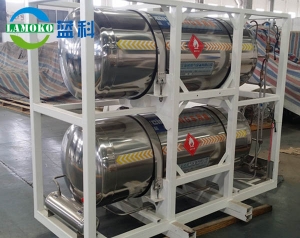

Contacts:Mr. Pan
Mobile:13390831768
Landline:0512-82592088
Fax:0512-82592078
Mailbox:phj@lamoko.com
Address:No. 36 Renmin Middle Road,Zhangjiagang
Website:monodo.cn.en
The purpose and method of adiabatic
The purpose of cryogenic insulation is to reduce the heat transfer from the environment and the LNG.For low temperature storage tanks, the gasification loss can be reduced or the conditions for long storage and long distance transport can be created.Especially for LNG liquefaction and LNG storage containers, without good insulation, liquefaction and storage are difficult to achieve.Therefore, cryogenic insulation is not only economic, but also technical.In addition, the insulation of the equipment and pipes can also avoid the appearance of dew and frost, which can also avoid the cold feeling or even frostbite.This is necessary to improve working conditions and prevent accidents.
How do you keep the liquid at minus 162 degrees Celsius?-- LNG cold insulation technology
2. Classification of adiabatic methods
The low temperature adiabatic is divided into ordinary adiabatic and vacuum adiabatic.
1. Normal (accumulation) insulation
Ordinary insulation is a kind of early traditional adiabatic method, it is in the equipment, containers, the outer edge of the pipe laying solid porous thermal insulation material, and the gap in the thermal insulation material is full of atmospheric pressure air or other gases.This adiabatic method has poor adiabatic performance, but its structure is simple and cheap, so it is widely used in the case of low adiabatic demand.Now the pipeline of LNG plus liquid station USES this kind of adiabatic method more.
2. Vacuum insulation
Vacuum adiabatic is to make adiabatic structure into a sealed sandwich, internal space is drawn to a certain vacuum degree, to reduce the incoming of heat.There are three basic types of vacuum insulation: high vacuum insulation, vacuum porous insulation and multi-layer insulation.
2.1 high vacuum insulation
Also known as pure vacuum insulation, it simply draws the vacuum of the interlayer to 1.38* 10-3pa (1.0* 10-5mmhg) 1.The usual vacuum vacuum cup is used in this kind of adiabatic way.In a vacuum sandwich, there are only two walls between the radiation heat transfer and the thermal conductivity of the residual gas in the sandwich.If the inner surface is polished, or coated with a reflective material, a good vacuum sandwich is formed to reduce the heat transfer.The adiabatic structure is not very good because of the radiation heat exchange.But it has the simplest structure, light weight and small heat capacity, so it has been widely used since the beginning of the last century.
2.2 vacuum porous insulation
It is filled with porous adiabatic material in the sandwich and then draws to a certain vacuum.From the convenience of technology, it is generally filled with powder materials or fibrous materials, so this adiabatic method is also called vacuum powder adiabatic or vacuum fiber insulation.Vacuum interlayer insulation weakened in the wall between the radiation heat transfer, so it's thermal insulation performance is better than high vacuum insulation, can reduce to the requirement of the vacuum, generally 1.33 Pa (about 10-2 MMHG).If to the powder or adding a certain proportion of reflective fiber material of metal powder, such as aluminium or copper powder, to reduce the materials in powder particles or fibers between the radiation heat transfer is called blocking light effect, can make the thermal insulation performance is greatly improved.Vacuum powder and vacuum fiber insulation are now widely used in the storage and transportation of LNG liquids.
2.3 vacuum multi-layer insulation
It is a vacuum sandwich that loads a lot of radiation screens to reduce the heat transfer between the walls.There are two basic forms of multi-layer adiabatic, one is to use metal foil as the radiation screen, and the space between the screen is filled with low thermal conductivity.One is a polyester film that USES a single spray of aluminum to make a radiation screen, and it is suppressed into corrugated forms to reduce the heat of contact between the screens.The vacuum multilayer insulation requires a vacuum of about 1.3* 10-2pa (10-4mmhg).Vacuum multilayer insulation is one of the best way of adiabatic current adiabatic performance, often referred to as the "super adiabatic", usually for LNG/liquid hydrogen and liquid helium storage containers, is also used in small liquid oxygen, liquid nitrogen container.The disadvantage of multi-layer insulation is that the construction is more troublesome, the cost is higher, and the adiabatic performance is changed with the construction quality.
The gates foundation to support the barrels of life and the way of adiabatic and partition radiation effect better, just higher vacuum degree and the finished product for the green barrel, can be in the hot desert and dry ice to maintain 0 ℃ for a month!
Iii. Rating of adiabatic performance
The adiabatic performance of adiabatic structure can be evaluated by its effective thermal conductivity coefficient (or the apparent thermal conductivity coefficient, including convection and radiation heat exchange). The smaller the numerical value, the better the adiabatic performance is.In figure 4-2, the variation range of effective thermal conductivity coefficient is shown in various adiabatic modes.As can be seen from the graph, the adiabatic performance of multi-layer adiabatic is much higher than that of other adiabatic methods, and the adiabatic performance of non-vacuum adiabatic mode is the worst.

2. Currently used in the low temperature adiabatic technology of LNG
2.1 the vacuum is adiabatic and the pearlescent sand is used as the filling medium.
The representative product is LNG fixed storage tank, as shown below:
2.2 vacuum multi-layer insulation:
The aluminum foil composite is used to wound the inner gallbladder, and the sandwich is pumped into a high vacuum to achieve optimal adiabatic effect.Representative products: dewar bottle, car bottle, quick and easy cold, low temperature tank, tank, etc.